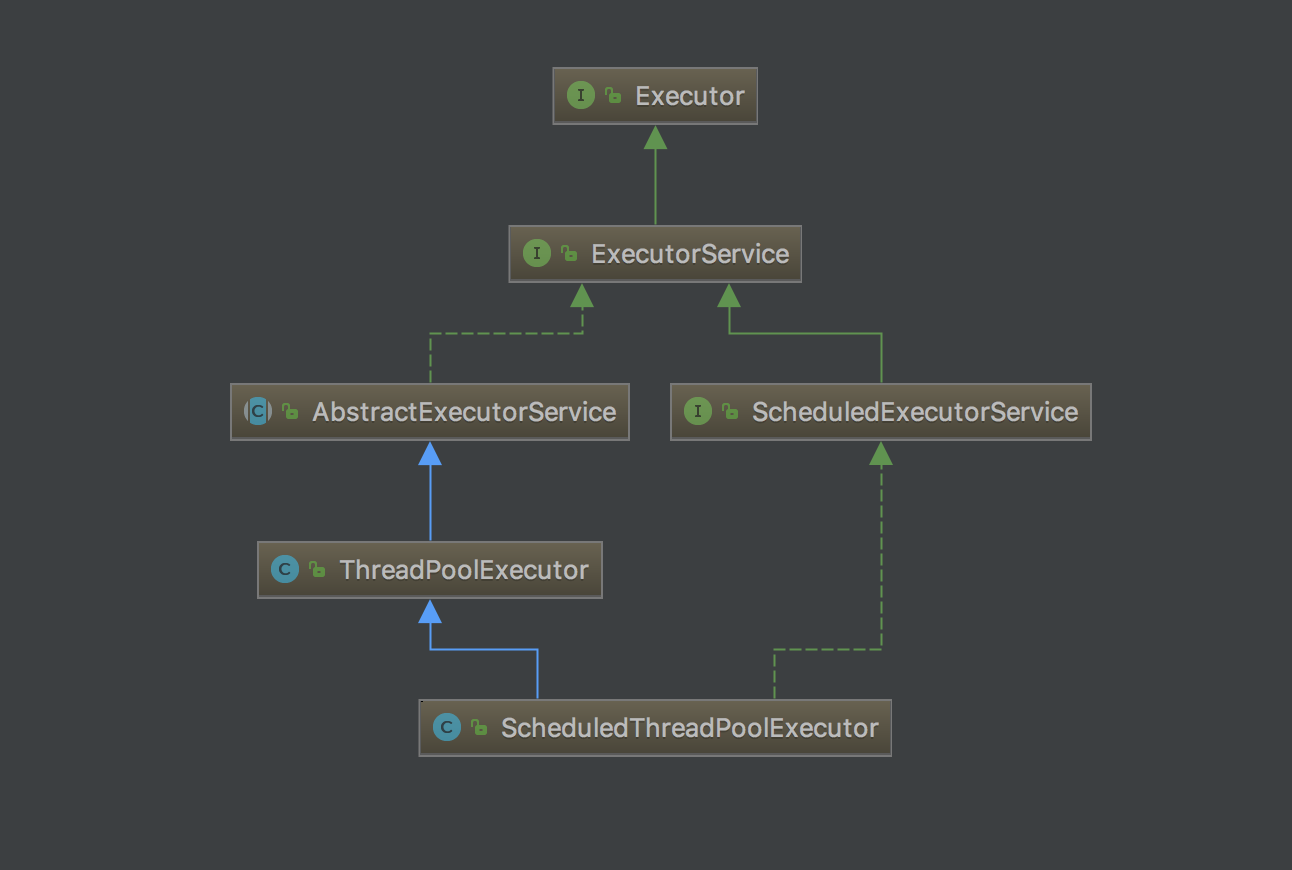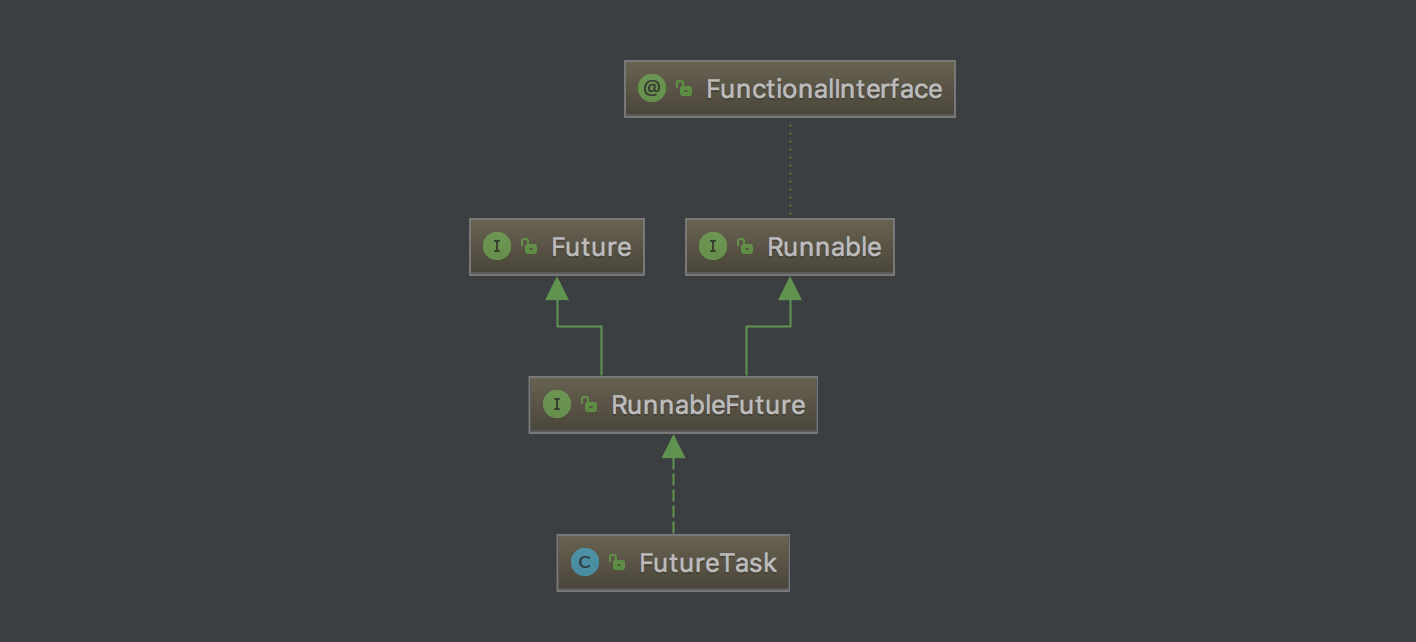Executor是JUC包中用于实现异步任务的框架,使用它可以有效降低并发编程的复杂性。整个框架大致可以分为三个部分:用于执行任务的Excutor,任务本身Runnable或者Callable,及异步获取执行结果的Future。下面就通过这仨个部分简单介绍下Executor的整体架构。
Executor
Executor接口是框架的核心,它下面有 一系列的继承体系,主要实现类有ThreadPoolExecutor和ScheduledThreadPoolExecutor和一个工具类Executors。下面看一下Executor的继承体系,两个实现类的具体实现我们在后续的文章中再详细分析。

下面我们按照这个继承图依次了解一下它们的源码。先看一下最上层的Executor接口,它的源码如下:
1 | public interface Executor { |
可以看到它内部只有一个待实现的execute方法,用于执行任务。我们也能看到它采用了设计模式中的命令模式,将任务的调用者和处理着解耦分离,我们不需要了解任务是如何执行的,我们只管向里面放入任务即可。Executor有一个子接口ExecutorService提供了更多的功能,下面我们看一下它的源码。
它提供了如下的接口方法:
1 | // 等待线程全部执行结束,成功返回true,超时返回fales |
以上就是ExecutorService接口中提供的可供实现的方法,我们需要重点关注的是它的invoke,shutdown,submit等方法。它为Executor框架制定了基调,后续的实现类再进行自己的实现。本篇博客只是大而全的介绍下Executor框架的结构,具体实现类,比如ThreadPoolExecutor和ScheduledThreadPoolExecutor,笔者打算在后面博客再进行详细介绍。
Runnable & Callable
Runnable是一个比较古老的任务类型,早在JDK1.0就已经存在,在很长的一段时间类,它都是作为Thread对象的靶对象使用,即通过线程调用它来执行一个任务,它的源码如下:
1 |
|
可以看到它只有一个run方法,用于执行具体的动作,当然,我们看到它上面多了一个注解,这是从Java 8开始对它进行了Lamdba表达式的支持。但是逐渐的它的功能不再足够,比如它无法抛出异常来展示线程执行失败,也无法返回线程执行完成的结果,我们必须通过其他方法来间接的达到这个目的。因此从JDK1.5开始Java提供了一个新的任务类型Callbale来替代它,我们来看一下Callbale的源码。
1 |
|
我们可以看到Callable与Runnable很像,只是将run方法替换成了call方法,不同处在于Callable是支持泛型的,它可以返回任务执行的结果,并且可以抛出异常。
Future
上面我们介绍了任务的调用者与任务的具体执行者,那么还剩下的一部分就是如何获取任务的执行结果,这样就构成了完整的Executor框架,而获取任务结果就是由Future来完成的,下面看下它的继承结构。

下面我们先看看Future接口中有哪些方法,它们的源码如下
1 | // 如果任务还没有执行,取消它;如果已经执行,传入true尝试去中断它,传入false则任务会继续执行完毕。正常取消了线程返回true,没有成功取消或者线程其实已经执行完成,则返回false |
上面就是Future提供的待实现的接口方法,它的主要实现类是FutureTask类。从上面的继承结构图中我们可以看到FutureTask继承于RunnableFuture,而RunnableFuture继承于Runnable和Future。所以FutureTask同时也具有Runnable的特性,这说明在传入Runnable的地方也可以传入FutureTask,比如上面Executor的execute方法,直接向里面传入FutureTask对象也是一种获取任务结果的方法,可以实现和submit一样的功能。
总结
本篇博文就简单介绍下Executor的整体架构,后续博客笔者将继续详细介绍Executor框架中FutureTask,ThreadPooExecutorl,ScheduledThreadPoolExecutor,Executors等成员的具体实现细节。